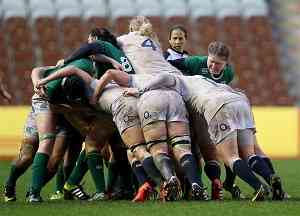MAUL RUGBY: This guide highlights the key difference between a ruck and a maul.
It is important for players to understand rugby union maul laws and the rules which govern rucks and mauls.
The most significant contrast concerns the ball. It would be in hand during a ruck. Whereas, the ball would be on the ground when a rugby ruck takes place.
Even so, the rules of rugby union for the offside line regulation would apply to both plays.
Maul Definition and Rugby Ruck Rules
The official definition of a maul in rugby is when three or more players are all in contact together. But, the rules stipulate that a rugby maul must include at least one player from each side. This is in addition to the player who is carrying the ball.
Players can only join a ruck and rugby maul from behind the furthest back teammate. That rule refers to the hindmost foot of the last player who is bound to the tussle. Joining a maul from the side will get penalised by the match referee.
Mauling rugby laws also regulate how players enter the ruckus. To join in, you must have your head or shoulder above your hips. You must also have at least one arm bound together with one of your teammates.
Health and safety Rugby Laws of the Game apply to rugby rules rucking and mauling. They do not allow the team without the ball to collapse the rugby maul ‘deliberately‘.
Penalties are also incurred for attempting to drag players ‘physically‘ out of the maul in rugby union. The exception is if they do so ‘legitimately‘ to opposition players who are on the wrong side of the ruck and maul.
Obstruction in Rugby Maul Rules

Obstruction in maul rugby rules is an infringement. It rarely goes unpunished by the referee in the modern game. The term ‘truck and trailer rugby’ offence occurs when a player screens the opposition.The result blocks tacklers from reaching the ball carrier.
Rugby guides suggest the law gets circumvented if two or more team-mates move forward while binding around the ball together.
The referee often allows a maul to continue providing the tackler has a reasonable opportunity to contest the ball.
Calling a Scrum
If positional players fail to drive the maul forward the match official will intervene, as a rule.
Shouting the phrase ‘use it or lose it‘ to the team in possession directs them to pass the ball within 5 seconds. Failing to release the ball gives the referee little option but to call a scrum.
Calling a scrum is a quick and safe method of restarting play as fair as possible for both teams.
But, ball possession and feeding it in to the scrum gets awarded to the team not in possession. That penalizes the team in possession for not releasing the ball earlier.
The exception to this rule of possession is when a player catches the ball from a kick-off or a drop-out. It applies if they get drawn into the middle of a rugby maul inside their own 22 meter line.
Note: The result is that the referee awards feeding the scrum to their team in such a situation. The end of a maul in rugby union occurs when the ball gets passed out or is loose and available on the ground.
ALSO IN THIS SECTION
Basics of Rugby: A simple list of the most important regulations of rugby.
Laws of Scrummaging: RFU rugby rules and regulation for the rugby scrum.
Forming a Scrum: How to form the scrum according to Rugby Union Rule 20.1.
Rugby Equipment List: A checklist of basic match kit needed for the game.
Rugby Union FAQ: Find the answers to the most asked questions in rugby.
Rugby Player Positions: How do 15 players fulfill different roles and responsibilities?
Rugby Terminology: A concise list of rugby terms and phrases from A-Z.
World Rugby Union Laws of the Game Official Rule Book [PDF Download Option].

